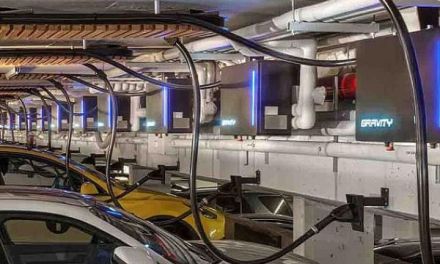Most people hate being stuck in traffic. But being stuck in traffic doesn’t have to be a waste of time. Japanese drivers can now charge their electric vehicles (EVs) while they wait.
Japanese researchers are preparing a pilot program in Kashiwa City, Chiba Prefecture, near Tokyo. The pilot program will embed wireless charging technology into the city’s road surfaces.
The purpose is to enable EVs waiting at select traffic signals to receive a 10-second wireless charge. This will give the EVs an additional range of approximately 1 km (0.6 miles).
If successful, this technology could be implemented at all traffic signals in the city. If this were to happen, the EVs would receive a 10–20 mile range boost, depending on the number of red lights encountered.
According to TechRadar, this in-motion power supply system incorporates vehicle detection technology to minimize standby power wastage. In addition, the charging coils embedded in the road are made of a tough, durable material that can withstand the weight of daily traffic.
The research is being conducted by the University of Tokyo and private sector partners.
How the Kashiwa City project is unique
Although wireless charging for EVs is not a new concept, previous implementations have required precise parking over specific wireless charging plates. These methods have proven to be cumbersome, with slow charging speeds.
In the UK, the government has funded a trial in Nottingham where electric taxis can wirelessly recharge while waiting at the taxi rank. In a similar initiative, Volvo launched a wireless charging program in Gothenburg, Sweden, for electric XC40 taxis.
Nonetheless, the project in Kashiwa City stands out from all the rest. The Kashiwa City project is the first wireless charging initiative that physically integrates the charging coils into the road surface instead of relying on separate pads.
The Kashiwa City pilot program, which runs from October 2023 until March 2024, aims to validate the feasibility of embedded charging coils.
The future is bright for EV charging
If wireless charging proves successful, it could greatly benefit the EV industry and EV owners. Manufacturers would be able to use lighter and cheaper battery packs, as owners would receive small amounts of charge while going about their daily activities.
Moreover, drivers would no longer be dependent on charging stations that require a lot of space and are often busy or out of order. Owners could top up their vehicles while waiting at traffic lights, and charging cables wouldn’t be necessary.
This would be particularly beneficial for EV drivers who live in high-rise apartment buildings.
Additionally, the use of card-less payment systems in vehicles could address the payment matter. The vehicle could keep track of all the minor top-ups and settle the bill at the end of the month.
Since cars are parked for the majority of the day, the Japanese researchers should consider testing wireless EV charging underneath parking lots as a follow-up project. This could have an even greater impact than wireless charging underneath traffic lights.
Image Source: Nikkei Asia, https://shorturl.at/bEV19






